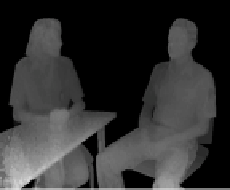Information Technology Reference
In-Depth Information
namely Omni-directional (panoramic) video, interactive multiple view video (free
viewpoint video) and interactive stereo video [11]. Stereoscopic video is the sim-
plest form of 3D video and can be easily adapted in communication applications
with the support of existing multimedia technologies. Stereoscopic video renders
two views for each eye, which facilitates depth perception of the scene. There are
several techniques to generate stereoscopic video content including dual camera
configuration, 3D/depth-range cameras and 2D-to-3D conversion algorithms [12].
Stereoscopic capture using a stereo camera pair is the simplest and most cost ef-
fective way to obtain stereo video, compared to other technologies available in the
literature. In this case, depth information can be extracted from the video obtained
form stereo camera setup. The latest depth-range camera generates a color image
and a per-pixel depth image of a scene. An example of the color and the depth im-
age is shown in Fig. 2. This depth image with its corresponding color image can
be used to generate two virtual views for the left and right eye using the Depth-
Image-Based Rendering (DIBR) method described in [13]. The depth information
is essentially required for 3D content display; therefore, it is always transmitted
along with the color information for 3D video communication.
255
Z
near
128
0
Z
far
(b)
(a)
Fig. 2
Interview sequence a) Colour image, b) Per-pixel depth image. The depth images are
normalized to a near clipping plane
Z
nea
r
and a far clipping plane
Z
far
.
The two virtual views for an image of 8 bits per pixel color depth are generated
using (1).
N
m
⎡
⎤
pix
P
=
−
x
(
k
+
k
)
−
k
(1)
⎢
⎣
⎥
⎦
pix
B
near
far
far
D
255
.
Here,
N
pix
and
x
B
are the number of horizontal pixels of the display and eye separa-
tion, respectively. The depth value of the image is represented by the
N
-bit value
m
.
k
near
and
k
far
specify the range of the depth information respectively behind and
in front of the picture, relative to the screen width
N
pix
.
D
represents the viewing
distance.






